danbricklin.com/log
|
||
|
|
Starting July 17, 2007
Video interviews with Virtual Ubiquity and Adobe executives as well as Don Bulens of EqualLogic, Scott Kirsner's "Think Big" get-together, Sprint says tractor trailer faster than a Porsche, More about Microsoft Surface, Video of Microsoft Surface demo, Vilna Shul Fireside Chat with Irving Wladawsky-Berger, Congratulations Don Bulens and EqualLogic, Essay about gestures and the iPhone, Tech Blogs discussion podcast led by Scott Kirsner, Podcast of Bug Labs CEO Peter Semmelhack, Podcast of MTLC meeting about the Microsoft/Novell deal, Podcast with SpotScout founder and CEO, "Why Facebook went west" podcast with Scott Kirsner, Tour of Eclipse Aviation with Vern Raburn, CPAL: The Open Source license SocialCalc will be using, SocialCalc Engine programmer documentation released
17Jul07-30Nov07
2007_07-17.htm
|
|
|
Video interviews with Virtual Ubiquity and Adobe executives as well as Don Bulens of EqualLogic [link]
I attended two parties yesterday and did some video interviewing instead of plain audio. The first was at Virtual Ubiquity's Office-Closing party. They are being acquired by Adobe and are moving from their Waltham, Massachusetts, start-up offices (on the same floor as Grazr -- which made it easy to visit them after attending Grazr board meetings) to Adobe's beautiful offices in Newton. They are creating the Buzzword web-based word processor.
In this 15 minute video I first interview David Coletta who created a lot of the UI polish of Buzzword. I held my heavy 3-CCD semi-pro camera somewhat low so my arm wouldn't get tired while holding a microphone in the other. I used a handheld mike to help keep the noise of the party to a minimum. Next I interviewed CEO Rick Treitman and CTO Mike Kraley. Standing next to them was Michael Kolowich, president and founder of DigiNovations, a local video production company. I know Michael from his days at Lotus and Ziff-Davis, but he also worked for CBS and WGBH-TV. He offered to do the camera work, so you get to see me a bit and have a much smoother experience overall -- thank you Michael! Finally, I interviewed David Mendels, Senior Vice President of Adobe's Business Productivity Business Unit. Even though he's in senior management, he works out of the Newton, Massachusetts, office, not headquarters in San Jose, California. His overall plan: They are focused more on collaboration than word processing, how people work around documents -- how they collaborate on documents and presentations -- and how to streamline the way people work.
Here's the video on Google Video:
After a while I ran off to Matrix Partner's holiday party. Matrix was one of the lead investors in Trellix and they invite me to their party each year (along with hundreds of others I assume). It's a great way to catch up with other entrepreneurs and people I've worked with.
I ran into Don Bulens, who was Trellix CEO, but is currently head of EqualLogic. As I blogged on November 6th, Don's company is being bought by Dell for $1.4 billion -- reportedly the largest all-cash exit (without going public, etc.) for a venture funded business. This is the sale that stymied people at Kirsner's event: This was a selling of a local company, but it wasn't "way before it gets to $1 billion". Don had just flown in from meeting with Michael Dell that morning. I pulled him into a somewhat quiet hallway and took out my pocket camera (a Canon 800 IS). I hadn't brought my big video camera nor podcasting equipment, not expecting to have time to record anything. Without a directional mike to keep out the noise in the room, I tried to keep the camera's little mike as near Don's mouth as possible, leading to weird close-ups of his chin. I shot almost 3 minutes of video, then we talked for a while, and then we were joined by Buzz Kelley (who was with us at Trellix) who had just arrived from the Virtual Ubiquity party (Buzz Kelley, Buzzword, hmm...). The pocket cameras produce quite good video for such things and I loaded it directly up to YouTube. You can compare it to the "pro" video at Virtual Ubiquity -- there is a difference in the sound (especially when you compare the hallway to being right in the middle of a party). Of course, YouTube and Google Video highly compress the video, so it's a lot worse than my originals (which were both quite good).
Here is a photo of me with the obviously happy Don:
 Here's the video on YouTube:
Scott Kirsner's "Think Big" get-together [link]
Tonight Scott Kirsner hosted another event. This one he put together with the help of the Boston Search Group, Wendy Caswell, Goodwin Procter LLP, and KMC Partners. It was held at Wendy's wonderful home high over downtown Boston. (Wendy is CEO of ZINK, a company developing inkless printing -- see their web site.)
Here's the write up about the meeting from the invitation (it was by invitation only):
"We have been selling the seed corn." - Paul Maeder
Are New England's most promising companies getting sold before they have a chance to get really big and really influential? If we're selling our seed corn, as Highland Capital co-founder Paul Maeder suggested recently, how can we cultivate a new generation of companies like DEC, Lotus, EMC, Akamai, Google, and eBay...companies that create entirely new business sectors, grow like crazy, and serve as the hub of new ecosystems?
At this event, we'll gather CEOs, founders, and investors from all industries. The main qualification is that everyone present will be involved in building companies of substance.
There will be schmoozing from 6:30 to 7:30, a group discussion from 7:30 to 8:30, and more schmoozing afterward. Leading the discussion will be:
- Michael Greeley, Founder, IDG Ventures; President, New England Venture Capital Association
- Scott Kirsner, "Innovation Economy" columnist, The Boston Globe
- Paul Maeder, Co-founder, Highland Capital Partners; Board member, National Venture Capital Association
Attendees included the founders of Thermo Electron, Avid, E Ink, and lots of others, Frank Moss (head of the MIT Media Lab), VCs, a representative from the State government, and more. It was quite a crowd, and many of them participated in the discussion.
I provided the sound system (wireless mike, wired mike, shotgun mike, Fender PA system, etc.) and podcasting equipment.
The hour-long podcast is on my podcast page as "Scott Kirsner's Think Big get-together".
Here are some photos:
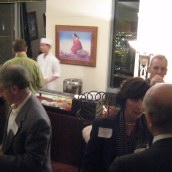 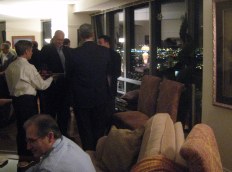 Schmoozing with sushi and a gorgeous view out the window
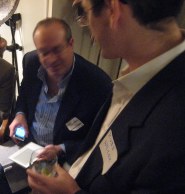 E Ink CEO Russell Wilcox watches as Bill Warner (founder of Avid and Wildfire) tries out an Amazon Kindle
 The "speakers", Paul Maeder, Scott Kirsner, and Michael Greeley
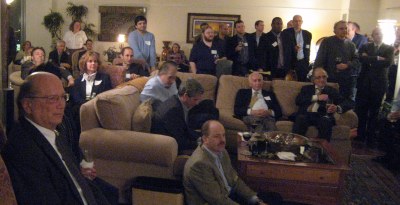 Some of the people as they listened (and then later participated)
Sprint says tractor trailer faster than a Porsche [link]
As a Treo 680 owner, I was a little interested in a Sprint ad in the newspaper today about the new Centro from Palm. It talked about Google Maps being faster, so I looked at the fine print at the bottom to try to learn exactly what they meant. They didn't explain Google Maps except as a trademark. However, there (and on their web site today) it is explained how they determined that Sprint has the "fastest national mobile broadband network": "Fastest claim based on total network size (sq. miles) multiplied by network upload/download speed capability. User's experience may vary."
So that's why they are the "fastest" -- they made up their own definition for the word "fastest". Instead of being "speed" (bits divided by time), it is "area times speed" (distance times distance times bits divided by time). By that logic, I guess a tractor trailer that has a maximum speed of 110 mph and a size of 210 sq ft (7' wide by 30' feet long) at 23,100 sq-ft-miles/hr would be "faster" than a Porsche 911 Turbo Cabriolet at 17,370 (193 mph times 15' by 6'). A longer trailer would make the truck even "faster".
To be fair, with a truck, that formula is a measure of something -- it is roughly related to how much "stuff" you can move per unit time. You might think that it could be related, in the broadband case, to total bits transferred by the whole network per unit time, but you know that coverage area does not necessarily translate into number of transceivers nor backbone capacity. In rural Kansas you don't need as many transceivers per square mile as, say, New York City. In other marketing material Sprints says fastest was "...based on national aggregate throughput capacity" or something, but I guess they are being more specific now. In any case, unless you own all of the phones, I wouldn't call it a good proxy for "speed" to most people.
For all I know, Sprint may actually be "faster" for me (in bits per second web surfing on my phone in my home) than the competition but this fine print disclaimer does not help me know that. It only makes me trust them less.
More about Microsoft Surface [link]
(Note: The video I posted last night was only intermittently available from Google Video for the first 12 hours or so. It was available when I posted about it here and seems to be available now. There's another copy of the video on Brightcove that might work better for some people. And, yes, I know I got the date wrong on the title -- it should be November 9th, 2007, but re-rendering all these videos takes too long to make it worth changing.)
I attended the last half hour or so of the public demo of Microsoft Surface in Boston. The crowds had lessened, they tell me, and I took some short videos which are also posted to Google Video (Microsoft Surface Boston Sheraton number 1, number 2, and number 3). Here's number 3, which shows the video jigsaw puzzle game:
Embedded video
These are demonstrations, where a demo person sits there and shows things off, with a little bit of interaction with the people standing around. This is not people sitting on both sides actually using it while they socialize without help. The applications are all, apparently, very canned demos that help show what you could do, but not anything like beta code of a real application. They do, though, show off lots of neat ideas to make some of the potential clear. Talking to one of the developers who was roped into doing demos at the last minute and who actually wrote some of the demo programs we saw running, the demos were early and many didn't use the SDK, etc. For all I know, this is pretty much some of the same demo code we saw months ago. As I heard yesterday, Microsoft is past this in the development lab and the SDK, but maybe not in complete applications ready to show the public. (They had better be -- these do not have the smoothness of an iPhone. Apple has always shown their exquisite polishing of the interactive "feel" of things, from the first Mac mouse through the iPhone.) To be used in bars, the UI better be easily discoverable to someone after a few drinks sitting with someone they are trying to impress.
If you haven't seen the long video, here's some of the bottom line: Rather than just direct contact input, Microsoft is committed to a platform that uses cameras to "see" what is happening just above/in front of the screen and uses recognition software to drive normal PCs running applications tuned to that new input. The cameras give more than just "touch" information -- they give full images (albeit something like high contrast black and white), with some varying degree of information so you get some sort of a "hover" (almost touching, like on most Tablet PCs) as well as the ability to recognize "things" like hands, bar-codes of various sorts (visible or invisible to the eye through use of infrared), and more. They are providing an SDK to make it easy to get to the generic UI like piles of objects to move and size (such as used in the photo application).
Microsoft is very much going it slow with a focus on their few partners, from what I heard. They claim the hardware won't be available for general "consumer" purchase and use for 5 years, though I assume they will either be pushed into it or someone else will try well before then. I encouraged Jeffrey Gattis of Microsoft to release at least the UI guidelines publicly (the SDK APIs are worth taking time to get solid) so at least those developing for the variety of touch platforms can think of the big picture of all the platforms, and not just, for example, the iPhone. Apple looks like they may push for leadership here, but they are giving out mixed messages, as I wrote in my Gestures essay. Gesture-controlled devices are getting out to the public in large quantities and certain interaction styles will become ingrained in many people -- remember QWERTY keyboards. Microsoft, if they believe they have something to offer, shouldn't miss their chance to influence those standards.
I also pushed Jeffrey to make individual units available to corporate and other developers to "play" with and explore the use of such systems in the specific space of interest to that developer. Microsoft could make units available at locations you go to, much as IBM, as I recall, has places to try out large systems. The more different people who experiment with their stuff now, the more likely successful full deployments will happen a few years from now.
I've been spending time here on my web site covering gestural interfaces on some of the devices related to my work. I think that, finally, gestural interfaces are going mainstream. (Remember, I was involved in "pen computing" back in the early 1990's.) There are already at least two very successful "consumer" devices -- the Wii and the iPhone -- and the Microsoft Surface systems look like they could also be commonly accepted devices next year, at least in some applications. (I agree with the Starwood people that hotel common areas could work very well with such devices where they are much better suited than "lobby PCs" for being used socially and connected to the hotel "systems" and services.)
Video of Microsoft Surface demo [link]
Microsoft is showing their upcoming Surface Computing system in various cities. They are putting it on display for the public tomorrow at the Sheraton hotel in Boston. They invited some of us, both traditional press and bloggers, for 30-minute private sessions either Friday or Saturday. I opted for the 11 am slot on Friday, which turned out to be the first slot.
Before going, I looked at the material Microsoft put on the Surface web site, including the demos, as well as some other demos on the web. Rather than just go through the standard demos, I asked lots of questions that tried to get at the capabilities of the system so that technical people trying to learn more about this might get a little more information. I even hung one of the apps, sort of (this is months before they plan to ship).
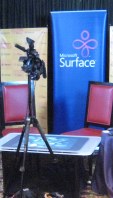 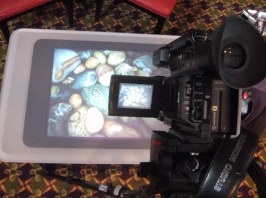 I brought video equipment and videotaped the entire 30+ minute session. I have it available on Google Video as video and also on my podcast page as an audio-only podcast. In addition, I ran into a PR person from Starwood Hotels and Resorts (which includes the Sheraton) and recorded a short podcast with her about how Starwood plans to deploy the units.
The video is "Microsoft Surface Demo with Gattis and Bricklin" on Google video, and the podcasts are "Audio of Microsoft Surface demo video" and "Starwood PR person talks about Microsoft Surface" on my podcast page.
I've also added some Microsoft Surface links to the Grazr reading list on my Gestures page.
Vilna Shul Fireside Chat with Irving Wladawsky-Berger [link]
Doug Levin of Black Duck Software hosted another Fireside Chat at the historic Vilna Shul on Beacon Hill in Boston tonight. The "chat" was with Irving Wladawsky-Berger, until recently with IBM, and a very senior person involved in their technical strategy and innovation initiatives. He's now teaching at MIT. It was an excellent talk. I managed to connect my recorder directly into the sound system, and use a shotgun mike for questions, so the podcast came out quite well.
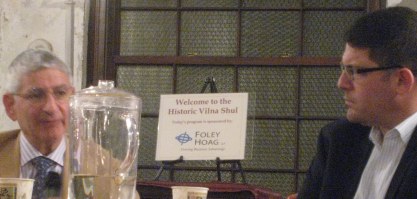 Dr. Wladawsky-Berger and Doug Levin
Irving talked a lot about how R&D helps keep a company alive in the future, and how "near death" experiences, such as IBM went through before its Internet strategy, can be helpful. Two big transformations were the IBM 360 series, when the anarchy of different machines and operating systems gave way to families of compatible machines and software, and bringing the Internet to every type of business (as opposed to only new, "net" businesses). Doug asked him about various IBM CEOs and his characterization of them. He remembered the decision to get behind Linux and how quickly the company adopted it (14:30), and the decision to get out of PCs (17:30). He talked about Google, thin clients, and more. His comments about Microsoft and its reaction to Linux and what that says about their culture (starting at 54:20) are quite interesting.
The podcast is on my podcast page as "Vilna Shul Fireside Chat with Irving Wladawsky-Berger".
Congratulations Don Bulens and EqualLogic [link]
Longtime readers of this blog should remember Don Bulens. He was CEO of Trellix during the development of Trellix Web (with which I write this blog post) and Trellix Web Express all the way through the acquisition by Interland. He later joined EqualLogic as CEO. Yesterday Dell announced that it was acquiring EqualLogic for about $1.4 billion -- reportedly the largest cash acquisition of a venture backed startup. Congratulations, Don! (And congratulations to investor Charles River Ventures, which was also the first VC to give money to Trellix, and the other investors.)
In Robert Weisman's article about the deal in the Boston Globe this morning, it says that Dell plans to expand their presence here in the New England area through growing Don's company (located in Nashua, NH) and another. Don is staying with the company.
People who know Don may wonder about another aspect of the deal. In the Globe article Rob also wrote "...And it marks the embrace by Dell, a company that's championed a direct-to-consumer sales model, of a technology that's been marketed successfully through a sales channel." Don is well-known for his skill with the VAR (value added reseller) channel. He used it very successfully for Lotus Notes when he was at Lotus, and used it at EqualLogic.
About two years ago I recorded a 20 minute interview with Don while we had lunch. In it he discusses EqualLogic, what they do, why he joined them, what he hoped to accomplish, and the makeup of their VAR channel. Listening to it this morning, I found it quite interesting in light of the Dell acquisition. You'll learn more than in the news articles that focus on just the dollars and general idea of storage.
The podcast is "Lunch with Don Bulens CEO EqualLogic".
Essay about gestures and the iPhone [link]
I just posted an essay with thoughts about gestural interfaces -- specifically computers controlled by direct contact with the screen, including the Apple iPhone.
The Safari browser running on the iPhone is different in some important ways from a normal browser on other platforms. Since the iPhone is an important new platform, and I've been interested in various user interfaces, I purchased an iPod Touch (which is basically the same system with respect to browsing). After using it and learning details about writing HTML and JavaScript for it, I was moved to write an essay about gestures and standards. I cover some thoughts about gestures, some legal issues, and the leadership the industry and developers like myself need.
As a developer, I was tempted to use the limited gesture recognition capability currently exposed to developers and try to innovate there to meet my needs. (You mainly get mouse-up events, no dragging.) The more I thought about it, though, the more I realized that given that an SDK of some sort is coming out in a few months, innovating with those restrictions might not be the right thing to do, at least not as part of a product I want to release with UI code that impacts the overall design. This made me think even more, and hence the essay.
To help explain where I'm coming from with respect to gestures, I put a copy of an old GO Corporation video up on Google Video as "PenPoint Demonstration 1991". For about an hour, PenPoint operating system architect Robert Carr demonstrates the system in great detail. PenPoint's gesture system may seem quite extensive after seeing the seemingly simple one on the iPhone, but with "two-fingered flicks", double-tapping to toggle, and other somewhat obscure gestures already being used by Apple, the iPhone set of gestures might end up just as extensive.
(I converted the old videotape to DVD using my Panasonic DMR-EH75V and then loaded the VOB files on the DVD into my review copy of Adobe Premier Elements 4 that I just got from Adobe. This was my first time using version 4, and I mainly used it to just add a title and render it to MPEG for uploading. This new version seems even nicer than the last, with a big area for previewing, and easy moving through the video. So far so good from my viewpoint. I've be using version 3 quite a bit the last year, and before that I used Final Cut Express HD on the Mac. In today's world for many people it's important to be able to express yourself in a variety of media, so knowing how to edit video is becoming important. I'll be putting Premier Elements 4 through more testing later.)
I also added a Grazr reading list to the end of the essay, with links I can maintain to related material using the new Grazr editor. Included in my reading list are other reading lists maintained by other people, something Grazr makes really easy. (I'm on the board of Grazr and this is my first real use of it on my site. Feedback would be appreciated.)
Tech Blogs discussion podcast led by Scott Kirsner [link]
Tonight I attended one of the salon-like get togethers in the Boston area organized by Scott Kirsner and some others. The invitation said: "Entrepreneurs, CEOs, VCs, journalists, and PR professionals are increasingly cranking out blogs, podcasts, and video dispatches. How does this change the way the tech sector gets covered? What does it mean for CEOs trying to get their stories out, PR firms trying to get coverage for their clients, VC firms touting their investments, journalists trying to cover important news, and customers tracking the market? (Not to mention the relationships between all of these players.) We'll bring together representatives from all four camps for a wide-ranging conversation (definitely *not* a panel) about the way blogs are changing the game in the tech world."
Scott led the hour-long discussion. There were some "panelists" sitting up on stools at the front of the room, but there was just as much discussion from the rest of the room. I provided the sound system and recorded it as a podcast (the speaker system makes it a little more likely that people would hold the mike right, and the large room and many attendees meant that some amplification was helpful).
The podcast is on my podcast page as "Tech Blogs with Scott Kirsner".
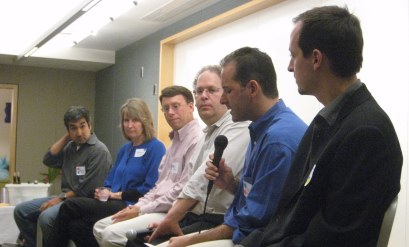 The "panel"
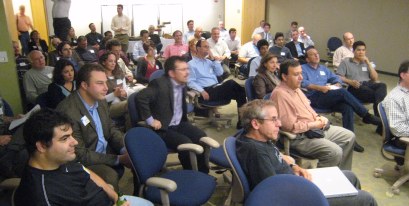 Most everybody else (except for me)
Podcast of Bug Labs CEO Peter Semmelhack [link]
Last night I attended a get together hosted by Bug Labs at a club in Cambridge, MA, near MIT. I recorded a 45 minute podcast of Bug Labs CEO Peter Semmelhack answering questions from me, Bob Frankston, and some other attendees that sat near us.
 Peter Semmelhack of Bug Labs (at dinner afterwards)
Bug Labs is producing "...an open source, modular consumer electronics platform that makes building hardware just as easy as writing software or Web applications." It's a main unit running the OS and Java, with snap-in modules like screens, motion detectors, cameras, and more, totaling about 5"x2.5" by 1" thick or so. They didn't bring a demo unit, though promise to next time. They hope to ship in a few months if all goes well.
The podcast is on my podcast page as "Bug Labs CEO Peter Semmelhack".
There were lots of people there, but I didn't get time to talk to enough of them. I did get time to talk to SJ Klein about the One Laptop Per Child's XO, and also to play with one of the two he brought (including the latest version - even nicer than before). I spent time with John Resig, JavaScript Evangelist for the Mozilla Corporation, talking about the work I'm doing rewriting the JavaScript for SocialCalc (more on that soon, I hope -- that's where most of my time has gone the last couple of months).
Here are some more pictures:
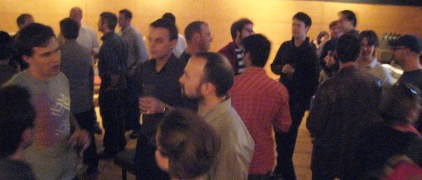 Some of the attendees
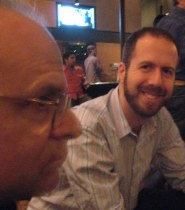 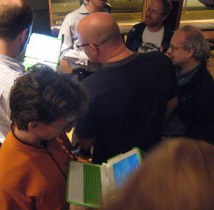 Bob Frankston and Jeremy Toeman of Bug Labs marketing, SJ Klein Director of Community Content at One Laptop Per Child and others with the XO computers
Podcast of MTLC meeting about the Microsoft/Novell deal [link]
The Mass Technology Leadership Council Open Source Cluster had a meeting this morning where representatives from Microsoft and Novell discussed the agreement they made almost 11 months ago. The panel was moderated by John Palfrey of the Berkman Center, and included people who worked on the deal. I recorded it and it's available as a podcast.
A few of the highlights that I recall: This was done because customers told Microsoft that they expect Microsoft to reach out and have a bridge to Open Source Software (at 9:50), the Mono project's Silverlight Linux port called Moonlight is "endorsed" by Microsoft (22:20), Suse Linux sales are up 243% (34:00), and this deal got Linux into Walmart's IT department (57:50).
To listen to the 1 hour and 33 minute recording, go to "Microsoft & Novell: Building Bridges" on the MTLC OSS Cluster podcast page.
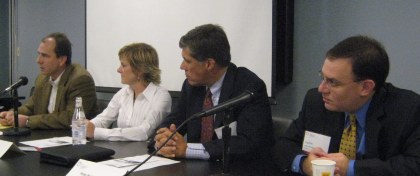 The panel: Carl Brandt, Senior Attorney, Microsoft, Susan Heystee, GM Global Strategic Alliances, Novell, Peter Rodrigues, Director Intellectual Property & Licensing, Microsoft, Justin Steinman, Director of Marketing, Novell
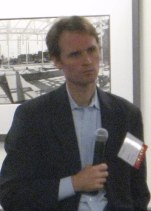 John Palfrey, moderator
 Some of the attendees
Podcast with SpotScout founder and CEO [link]
I was invited to a "networking" event hosted by GlobalLogic and TriNet at a club at Fenway Park (where the Boston Red Sox play, but not tonight). It included a tour of part of the park, including the special "Monster Seats" above the Green Monster wall and the press box.
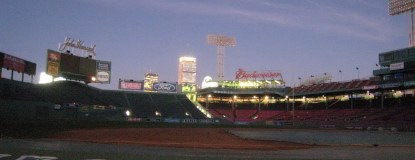 The dark, empty ballpark
I ran into my friend Les Fagen, an attorney, and we started talking with two young entrepreneurs. It was interesting, so I asked if it was OK to do a podcast, and they said yes, so here it is. The company is SpotScout. In a few weeks they plan to launch a free service for finding (and selling) parking spaces, even the ones in your driveway. They are a local company (yay!), located currently midway between Harvard and Tufts universities in Davis Square, a place I used to hang out in when I was younger and still visit periodically now. Their CEO, Andrew Rollert, explains their business model, what special stuff they have, how he came up with the idea, and more. Les asks some questions, too.
You can find the 15 minute recording on my podcast page as "SpotScout - A Boston Area Startup".
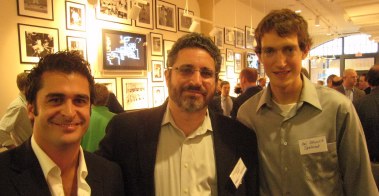 Andrew Rollert, Les Fagen, and Ari Ofsevit
"Why Facebook went west" podcast with Scott Kirsner [link]
Scott Kirsner has been a columnist for the Boston Globe in various capacities for many years. He's also been the interviewer in a variety of "Fireside Chats" for MITX that I've posted here as podcasts. After a 2-year sojourn in California, he's moved back to Boston. Doug Levin of Black Duck Software organized a "Welcome Back to Boston" event for Scott at the historic Vilna Shul, a synagogue in Boston. It was sponsored by the law firm of Goodwin Procter LLP and the venture capital firm General Catalyst Partners.
Scott has been blogging and vblogging on a variety of websites, including his Innovation Economy blog, and writing an Innovation Economy column for the Sunday Boston Globe. The column the morning of the talk was "Why Facebook went west", which became the focus of a discussion between Scott, Doug, and the attendees (a mixture of techies, VCs, lawyers, and other in the Boston area tech scene).
I didn't know the event was going to have a formal presentation, and only brought podcasting equipment to record one-on-one interviews. I ended up just placing the mike near one of the PA-system speakers, but the sound came out OK and you'll get a good idea of what the event was like (minus the schmoozing and good lox and bagels, whitefish salad, etc.). The "chat" with Scott lasted about an hour. The discussion ranged through a variety of topics related to Boston-area vs. Silicon Valley, blogging, Microsoft in Boston, and more.
There was also a short presentation by the executive director of the Vilna Shul, which I also recorded. Doug is on the board of directors of the Boston Center for Jewish Heritage, which is restoring the building and creating some educational history exhibits about it and the Jewish community in Boston.
You can find the recordings on my podcast page as "Welcome Back to Boston Event for Scott Kirsner" and "About the Vilna Shul in Boston".
You can find other blog posts about the event (and what we talked about) on Scott's site, Chris Herot's, and David Aronoff of IDG Venture's site.
Here are some pictures of Scott, Scott and Doug, and some of the others:
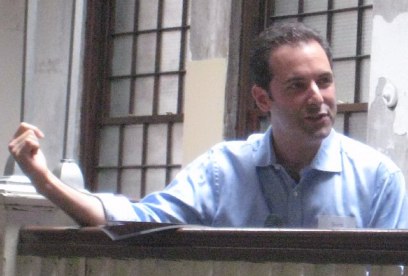 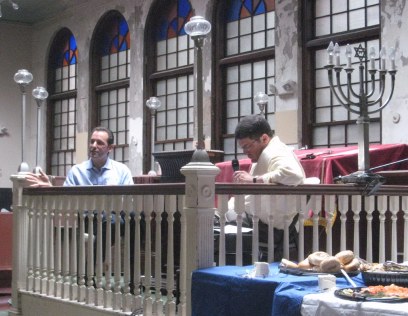 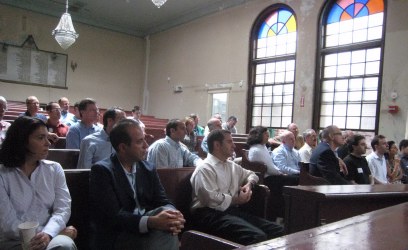 Tour of Eclipse Aviation with Vern Raburn [link]
Many of the followers of my blog remember Vern Raburn. He started one of the first computer stores in Los Angeles in the 1970's. He worked in the then-emerging PC software publishing business, ending up at Microsoft as an early employee and head of their "consumer products" division (that went on to do Word and Multiplan, and later Excel). After that he was at Lotus and Symantec. He was CEO of Slate Corporation, an early developer of application software for pen-based computers in the early 1990's co-founded by me and some other industry "veterans". We worked together for four years there. After a stint working for Paul Allen (and traveling constantly from city to city to help manage some companies), he founded Eclipse Aviation in 1998 to develop and manufacture Very Light Jets. These are jet planes that, at around $1.5M, are much less expensive than traditional jets. The company started shipping the first builds of their Eclipse 500 aircraft to customers this year. Customers range from air-taxi companies to individuals.
I've been hearing about Eclipse since Vern founded it. He had invited me to see the manufacturing plant years ago, but I never made it out that way. Finally, last week I managed to be in Albuquerque, New Mexico, where they are headquartered, and take a tour.
One of the premises of Eclipse, as I understand it, is that they will build planes more in the philosophy of the personal computer business (modular design, high volume manufacturing, lots of use of computers) and less like traditional aircraft manufacture (lots of custom assembly, intricate parts, low volume production). The question people have had is whether or not Eclipse would be able to design a plane that the FAA would certify (they did) and manufacture it in quantity. Until this summer, very few have been delivered, even though they got certified to produce them last April. That didn't fit with their need to ship multiple planes a day.
With this in mind, I was pretty blown away seeing their actual production facilities in operation. Dozens of planes were moving through a production line and I saw some literally about to go out the door. The company is entering the phase of moving from creating the design to optimizing the ongoing production. You can see how the original design should facilitate that optimization.
 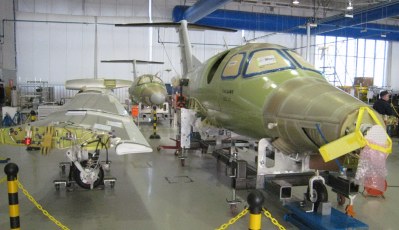 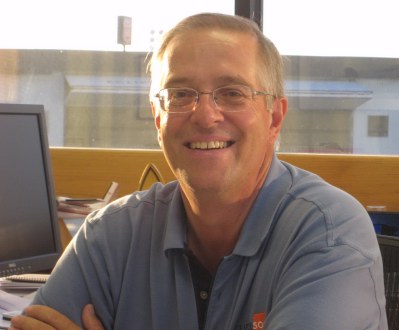 One of the factory buildings seen from the Albuquerque airport, planes being assembled, Vern at his desk
I know that some of my readers would love to see how these new planes are built, and others would just like to see Vern in his element. He let me take pictures and even some video (all done with my pocket camera, a Canon Powershot SD800IS). I put together an almost 9 minute video using Adobe Premier Elements 3.0, and put it up on YouTube. See "Visit to Eclipse Aviation". (I've also embedded it here.) Enjoy!
CPAL: The Open Source license SocialCalc will be using [link]
When Socialtext, Inc., joined the wikiCalc project last year they said that they would help run the project as an Open Source project and release the code under an Open Source license, though not the GPL as wikiCalc is. They have indeed been helping fund and staff development and have released the code under the name SocialCalc. That first release, from a licensing viewpoint, was a little mixed. The main engine, the part that actually does spreadsheet calculation, was released under a well-known Open Source license, the Artistic License 2.0. The rest of the product, though, was released under another license that had not been approved as "Open Source" by the Open Source Initiative (OSI). That was an interim solution while they worked with OSI to produce a new license that could win approval while still meeting Socialtext's business requirements.
Last week the OSI approved Socialtext's Common Public Attribution License 1.0 (CPAL). This license is based upon text from already-approved licenses, including the Mozilla Public License 1.1 (MPL) and others. Using existing language gave Socialtext a stronger case when arguing for approval. The older language, though, in some cases makes the "fit" with today's Web 2.0/SaaS applications a little rough. (How do you define "launch" for a CGI-script that runs on every web request?) I was involved some in the drafting, advising Ross Mayfield and his team at Socialtext, and did my best to help make it workable.
Now that the CPAL is approved we can apply it to SocialCalc in the next release. More about that when it happens.
The CPAL is an "attribution" license. That is, it allows the Original Developer who originally places the code under the license to require a display of attribution information while the program runs. There has been much discussion about these licenses, sometimes mocked as "badgeware". Some of it stems from licenses like the one for SugarCRM (version 1.1.3) which has terms like "the 'Powered by SugarCRM' logo must be visible to all users and be located at the very bottom center of each user interface screen. Notwithstanding the above, the dimensions of the 'Powered By SugarCRM' logo must be at least 106 x 23 pixels..." This brings up visions of systems made up of multiple products with such licenses with dozens of these logos fighting for center position with a NASCAR-like advertising look. Hopefully the CPAL will not lead to this result, and, as you'll see, there is good reason for that hope.
Attribution requirements are not foreign to the Open world. The old GPL 2.0 requires "...If the modified program normally reads commands interactively when run, you must cause it, when started running for such interactive use in the most ordinary way, to print or display an announcement including an appropriate copyright notice..." A popular Creative Commons license is the Attribution 3.0 license. This requires (in section 4.b) keeping copyright notices with the work and including "based on" notices in adaptations with an "at least as prominent" requirement. The author has always been treated specially in the Open world, sometimes for "moral" and fairness reasons in addition to the legal and business-model requirements.
I think the issue for many people with the SugarCRM-like licenses was the feeling of "overreaching" in the requirement. There's attribution and then there's requiring others to run your advertisements. Somewhere along that continuum is a line that people don't want to cross. The problem is that the position of that line varies from person to person and situation to situation.
I believe that the CPAL handles this well, taking the issue away from the license itself and dropping it into the lap of each individual licenser. (Disclaimer on what follows: I am not a lawyer. I do not represent Socialtext here, check with your lawyer, etc.)
The CPAL does not specify a specific form of displaying the attribution. It just says that "...the Original Developer may include in Exhibit B...a requirement that...a prominent display of the Original Developers Attribution Information...must occur." The specific form of that display is not in the license. As I read this, it is up to the Original Developer to provide that guidance when filling out an "Exhibit B". It is there that they put the "requirement". So, for example, the Original Developer may specify that the form of required notice is a 106x23 pixel logo at the bottom of every page, just like the SugarCRM license, but they could also instead specify that it be a copyright notice anywhere on the bottom of login-success pages, or something even less intrusive.
While the Original Developer may "require" whatever they want in Exhibit B, the CPAL makes it clear that the user modifying the program is only required by the license to meet certain minimum requirements. That is, Exhibit B may say that you have to display a paragraph of text along with specified background music. The license, though, states in Section 14 that the requirement may only be for up to 10 words and does not allow the additional requirement for sound. It is only in the case of when the modifier adds their own attribution displays that a "no less prominent" requirement enters into the picture, allowing a throttling up of image sizes or improving the placement to meet that requirement.
To make things less uncertain about what type of display meets the license's requirement for a prominent display, the CPAL also states that "If the Original Code displays such Attribution Information in a particular form (such as in the form of a splash screen, notice at login, an 'about' display, or dedicated attribution area on user interface screens), continued use of such form for that Attribution Information is one way of meeting this requirement for notice." I originally added this to the drafts. It is a way to have the Original Developer get what they want and have the modifier not worry if they are meeting the requirement and also make it easy for the modifier to know where they can cleanly add their own attribution. It is also a way to hint at some of the possible ways the Original Developer may say you can meet this requirement.
The "about" display was most important to me. It is a common, unobtrusive way to give attribution (and legal notifications), and is similar to the "show warranty" button suggested by the GPL 2.0 for meeting its requirements. The original wording of the CPAL, with mentions of "each time [it's] launched or run" and "splash screens", didn't seem to allow for the possibility of the Original Developer being satisfied with just an About box -- the new wording makes it clear that it does. Note that the CPAL doesn't say that an About display will always meet the requirements not matter what the Original Developer requires in Exhibit B. Quite the contrary, it just says that if the Original Developer considers something acceptable enough to provide it and state it as the requirement, then you don't have to do more, unless the "no less prominent" requirement enters the picture and the Original Developer hasn't waived that.
What this boils down to is: How "ugly" and "greedy" CPAL-licensed products look will be up to the Original Developer. They have a lot of latitude. They can use the license, get required attribution benefits, and still make a product that would look no different than one licensed under other licenses, including the GPL. On the other hand, if their marketing and business plans require, they can use the CPAL to ensure that their brand gets equal billing along with heavy branding added by others who modify the code and attempt to rebrand it. As with all licenses, modifiers always have the option of making a deal with the Original Developer to get a different result.
To help make it easier for developers considering the CPAL for their products, I've written the first draft of "How To Apply the CPAL To Your Product". This document is aimed at developers licensing their code. It is not a guide to developers who want to add code to an existing CPAL-licensed product. The goal is to make it easier for a developer who feels that the CPAL meets their needs better than other licenses, but who just wants a step-by-step guide listing how to fill in the blanks in the exhibits, where to put copies of the notices, etc. As time goes by, we will hopefully develop a library of "boilerplate" wording for the CPAL's Exhibit B that meet a variety of needs.
SocialCalc Engine programmer documentation released [link]
As part of participating in the SocialCalc Open Source project, I've just posted relatively detailed documentation of the Engine code. It includes overview documentation of the main data structures and routines, details about complex routines, and sample code. The sample code lets you experiment with simple testbeds to learn how to embed the Engine into other products or to test modifications to the code.
Links to the main copies of the documentation are on the Socialtext Open SocialCalc page in the Developer Documentation section.
As I explain last month, the SocialCalc code in broken up into two parts: the Engine and the App. The SocialCalc Engine is the main spreadsheet code that takes care of editing, calculating, and displaying the fully-formatted sheet. It is released under the Artistic License 2.0, which is compatible with a wide range of business models and licenses. The SocialCalc App is the part that manages the files and users, and implements the more detailed UI such as format setting, backup, etc.
The spreadsheet metaphor is a useful and well-known one for expressing things using a computer. It joins the word processing metaphor, the bitmapped editor, the 2-dimensional pasteboard, and other commonly used editing metaphors. Just like the frequent use of different "text editor" components in many software projects, you would expect that components for providing access to this metaphor would be useful in a variety of contexts, too.
There are many reasons to consider using the SocialCalc Engine in a project, be it an authoring tool like a blogging system or a social media system like a wiki. This engine is written in a well-known, ubiquitous scripting language (Perl), and can be run server-side or client-side. It can interact with the user through a browser. It can render to HTML for inclusion into other output. It has a "liberal" Open Source license, with complete source code available. And now, it has programmer documentation of that code.
If the assertion is true that it is a good thing to have Open Source spreadsheet components (with full formatting and calculation) available for inclusion in project as needed, then there is an interesting thing I've been thinking about: It would be good to have people (or companies) take on for themselves the relatively straightforward task of "translating" the SocialCalc Engine code into other computer languages and then keeping all those versions in sync. Two languages in particular come to mind: Python and Javascript. I have received a request from Ivan Krstic on the OLPC project for the Python version. (As an enticement to a developer, knowing that your code might end up in the hands of millions of school kids could be a draw. Anybody want to sign up?) The Javascript version would be so that we could make a client-only version work, but have compatibility with server-side code in case you want to offload long computations or do sharing of various sorts. A variant of the Javascript version could be an Actionscript version which would let you make it part of a spreadsheet with the UI in Flash, which could be really cool, especially for UI experimentation in research settings.
In any case, take a look at the documentation if you are interested. You might also want to follow some of the conversation on the Google Group for SocialCalc and maybe even join in.
|
||
|
© Copyright 1999-2018 by Daniel Bricklin
All Rights Reserved.
See disclaimer on home page.
|
||